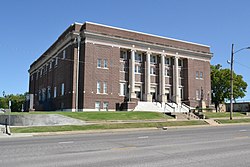Montgomery County, Kansas | |
|---|---|
 Memorial Hall in Independence (2017) | |
 Location within the U.S. state of Kansas | |
| Coordinates: 37°12′N95°44′W / 37.200°N 95.733°W | |
| Country | |
| State | |
| Founded | February 26, 1867 |
| Named after | Richard Montgomery |
| Seat | Independence |
| Largest city | Coffeyville |
| Area | |
• Total | 651 sq mi (1,690 km2) |
| • Land | 644 sq mi (1,670 km2) |
| • Water | 8.0 sq mi (21 km2) 1.2% |
| Population | |
• Total | 31,486 |
| 30,568 | |
| • Density | 48.9/sq mi (18.9/km2) |
| Time zone | UTC−6 (Central) |
| • Summer (DST) | UTC−5 (CDT) |
| Area code | 620 |
| Congressional district | 2nd |
| Website | mgcountyks.org |
Montgomery County is a county located in Southeast Kansas. Its county seat is Independence, [3] and its most populous city is Coffeyville. As of the 2020 United States census, the county population was 31,486. [1] The county was named after Richard Montgomery, a major general during the American Revolutionary War.
Contents
- History
- Early history
- 19th century
- Geography
- Adjacent counties
- Bodies of water
- State parks
- Demographics
- 2020 census
- 2000 census
- Government
- Presidential elections
- Laws
- Media with office hours in Montgomery County, Kansas
- Transportation
- Major highways
- Airports
- Bus
- Education
- Colleges
- Unified school districts
- Communities
- Cities
- Unincorporated communities
- Ghost towns
- Townships
- See also
- References
- Further reading
- External links


